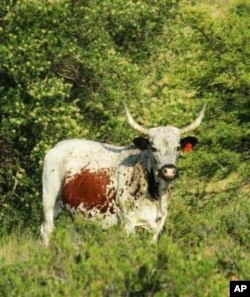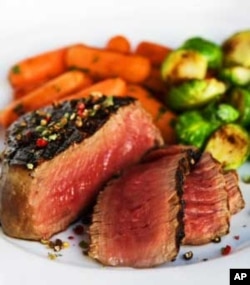Leading South African restaurateur Steve Maresch enters a large cold room, and gestures towards slabs of meat hanging from hooks. “It’ll be sirloin, rump down there, rib eye on top there; then T-bone,” he explains, “This is what we’re looking forward to serving to our visitors – prime South African beef.”
The beef expert is a member of South Africa’s national guild of restaurateurs – and just one of many South Africans preparing to feed about 450,000 international football fans during Africa’s first World Cup.
Unprecedented beef sales are expected in South Africa during the month-long football festival, given that supporters from six of the top 10 beef-eating nations on earth will descend on the country.
According to the latest statistics from the United States Food and Agriculture Department, Argentina is the world’s top per capita consumer of beef. On average, each Argentine eats a staggering 65.2 Kg (1 KG = 2.2 lbs) of beef every year. Australians are next, eating almost 50 Kg per person per year, while each American on average eats more than 40 Kg of beef annually. Uruguay, Brazil and France – countries that have also qualified for the 2010 World Cup – are also among the top 10 beef-eating nations.
South Africans eat a mere 16 Kg of the meat a year – still enough to place their homeland among the top 20 beef-consuming countries. South Africa also enjoys a reputation of producing some of the most flavorful beef in the world.
Incredible beef
Maresch’s love affair with beef began about eight years ago, when he visited a cattle ranch in South Africa’s northern Gauteng province.
“At Chalmar farm we discovered the most incredible beef we’d ever tasted and literally two weeks later, we’d opened the first of a few local grills,” he tells VOA.
The grain-fed beef he now serves in his restaurants – often rated by leading food critics as the best steakhouses in South Africa – comes from steers at Chalmar ranch. There, animals are fed only the finest natural grains.
“We also have the finest of free-range beef, or grass-fed beef, which comes from a farm in Kwazulu-Natal (province). And that’s very lush, green pastures (that the cattle graze),” Maresch says.
Greenfields ranch supplies free-range meat from cattle left to roam the misty hills and mountains, free to feed as they wish on mineral-rich grasses.
Our cattle are what they eat
Cattle in South Africa aren’t confined to one particular area, but are found all over the country.
“Our cattle are what they eat,” says Maresch. “Often it’s been said that South Africa is a world in one country – from lush, grassy pastures to quite arid regions, to mountainous areas, to savanna. It’s the best of all worlds in one here – which means the beef that we can produce is of the finest.”
Down the years, South African beef producers have discovered which particular breeds of cattle are best suited to specific regions containing specific grazing.
South African beef has an “edge” over that produced in many other parts of the world, says Maresch, because of the country’s “wonderful farmers,” who focus on quality rather than quantity.
“I think the farms have huge attention to detail, in all aspects, and we certainly have had the privilege of going out to the farms and walking the pastures, being out in the feedlots and understanding (the farmers’) total commitment (to producing quality beef).”
Humane treatment influences meat’s taste
South African farmers crossbreed traditional indigenous cattle such as Nguni, Afrikaner, Drakensberger and Bonsmara. “They’re trying to find and interbreed (animals) to produce better yield, better flavor, and a more consistent beef,” Maresch says.
The country’s beef is of the healthiest in the world, according to South African nutritionist Hettie Schonfeld.
“The beef consumed most often in South Africa contains only 13% fat - of the leanest when compared to global beef producers and thus making it perfectly acceptable to consume as part of a healthy balanced diet,” she says.
Maresch says many South African farmers also treat their herds as humanely as possible. “If cattle are stressed, no matter how good a breed it is, the meat isn’t going to taste as good because the animals produce all kinds of (flavor-killing acids) when they’re stressed.”
He adds that “quality” South African beef producers don’t inject their cattle with artificial growth hormones and steroids.
The aging process
The aging process affects how tender and juicy tasty a steak is. “From my experience, the aging process is one that any good steak has to go through, and aging is allowing the amino acids to be active (to) break down the muscle fibers,” says Maresch.
The meat is aged by hanging it in cold rooms, with temperatures between three and five degrees Celsius. Humidity is controlled by means of special filters.
“This allows our beef to be aged for up to 90 days, when vacuum packed. When the beef is in a vacuum pack, that’s called wet aging,” Maresch explains. “The cut lies in its natural juices and is allowed to mature.”
But there’s also dry aging – the meat arrives from the farm, and sellers keep it in a vacuum pack for up to two weeks.
“Then we take it out of the vacuum bag and hang it up on a hook in the cold room, allowing the natural elements to oxidize and age that piece of beef; it’s a faster process. (The steak) is dry on the outside and quite pleasant to eat,” he says.
Rubs and grilling
South Africans generally enjoy their meat barbecued. At Maresch’s restaurants, chefs rub the steaks with a blend of spices, including oregano, paprika, coriander, mustard seeds, salt and thyme.
“We then press our steaks into the rub mix. It’s then placed on the grill and brushed with salted butter while it’s grilling,” the restaurateur explains.
Most South Africans prefer their steaks medium rare, according to Maresch. But one of his grillers, Peter Mahlangu, says plenty also like their meat rare or even “very rare.” Maresch jokes that customers who order steaks well done are “allowed to leave out the back door.”
He continues, “It’s going to be interesting to find out what other famous meat eaters, like the South and North Americans and the French and the Australians think of our beef.”
The beef Maresch sells is the best he’s ever tasted, he says – and he’s eaten steaks all over the world, including in perhaps the most famous of cattle areas, Texas, in the United States.
“That’s not an arrogant sales pitch. I invite anyone – especially people who are going to be visiting us for the World Cup – to taste South African meat. I’m sure they’ll be amazed.”
He says it may well be that another international tournament will happen in South Africa at the same time as the football jamboree – the “Beef World Cup!”



















